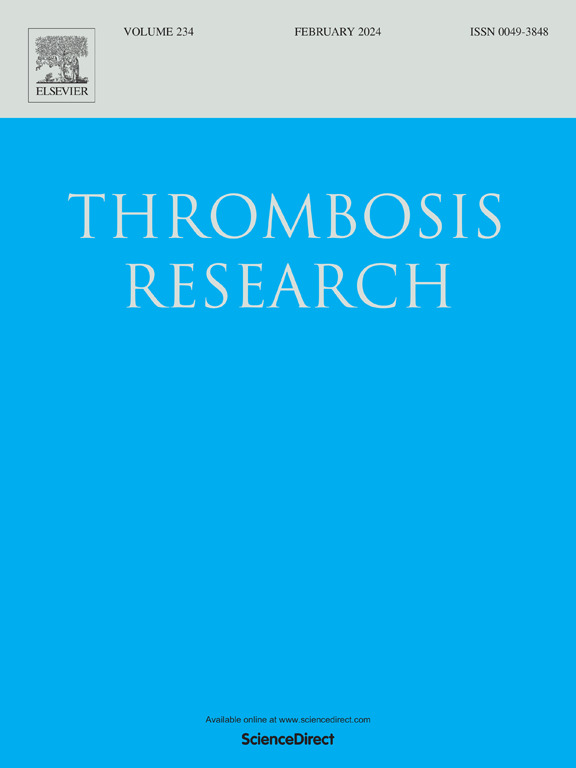急性肺栓塞中高危患者的临床表型和早期血流动力学恶化的风险
IF 3.4
3区 医学
Q1 HEMATOLOGY
引用次数: 0
摘要
中高危肺栓塞(PE)患者在症状出现后的早期面临临床突然恶化的高风险。我们对中高风险PE患者进行了分层聚类分析,以确定表型亚组,并评估其与入院48小时内血流动力学恶化风险的关系。方法对意大利肺栓塞登记处(ClinicalTrials.gov: NCT01604538)登记的中高危PE患者进行事后分析。分层聚类(沃德连锁)和主成分分析确定了中高危PE人群的表型聚类。结果纳入420例中高危PE患者(平均年龄72.4±13.8岁,男性63.8%)。确定了三个不同的表型集群:集群1,特征是收缩压在90至110 mmHg之间,急性发作呼吸困难,心电图右心室紧张;第2组,65岁男性胸膜炎性胸痛;第3组为胸痛≥65岁的女性。48小时血流动力学恶化率第1组为14.6%,第2组为7.5%,第3组为4.5%。多因素分析显示,第一类患者的恶化风险明显高于第二类患者(HR: 1.42, 95% CI: 1.38-1.46, p <;0.001)和3 (HR: 1.51, 95% CI: 1.15-1.62, p = 0.01),校正了年龄、性别和治疗。结论聚类分析在入院48 h内不同血流动力学恶化风险的中高危PE患者中发现了3个统计学上确定的表型聚类。进一步的表型分析是必要的,以告知患者护理和优化临床试验设计。本文章由计算机程序翻译,如有差异,请以英文原文为准。
Clinical phenotypes and risk of early hemodynamic deterioration in intermediate-high-risk patients with acute pulmonary embolism
Introduction
Intermediate-high-risk pulmonary embolism (PE) patients face elevated risks of sudden clinical deterioration in early hours after symptoms onset. We performed a hierarchical cluster analysis among intermediate-high risk PE patients to identify phenotypic subgroups and assess their association with hemodynamic deterioration risk within 48 h of admission.
Methods
A post hoc analysis of patients with intermediate-high risk PE enrolled in the Italian Pulmonary Embolism Registry (ClinicalTrials.gov: NCT01604538) was performed. Hierarchical clustering (Ward's linkage) and principal component analysis identified phenotypic clusters among a population of intermediate-high-risk PE.
Results
The study involved 420 patients with intermediate-high risk PE (mean age 72.4 ± 13.8 years, 63.8 % males). Three distinct phenotypic clusters were identified: Cluster 1, characterized by patients with systolic blood pressure between 90 and 110 mmHg, acute onset dyspnea, and right ventricular strain at ECG; Cluster 2, featuring males <65 years with pleuritic chest pain; and Cluster 3, females ≥65 years with chest pain. The rates of 48-h hemodynamic deterioration were 14.6 % in Cluster 1, 7.5 % in Cluster 2, and 4.5 % in Cluster 3. Multivariate analysis showed Cluster 1 had a significantly higher risk of deterioration compared to Clusters 2 (HR: 1.42, 95 % CI: 1.38–1.46, p < 0.001) and 3 (HR: 1.51, 95 % CI: 1.15–1.62, p = 0.01), adjusting for age, sex, and treatment.
Conclusions
Cluster analysis identified 3-statistically-identified phenotypic clusters among patients with intermediate high-risk PE with different risk of hemodynamic deterioration within 48 h from admission. Further phenotyping is warranted to inform patient care and optimize clinical trial designs.
求助全文
通过发布文献求助,成功后即可免费获取论文全文。
去求助
来源期刊

Thrombosis research
医学-外周血管病
CiteScore
14.60
自引率
4.00%
发文量
364
审稿时长
31 days
期刊介绍:
Thrombosis Research is an international journal dedicated to the swift dissemination of new information on thrombosis, hemostasis, and vascular biology, aimed at advancing both science and clinical care. The journal publishes peer-reviewed original research, reviews, editorials, opinions, and critiques, covering both basic and clinical studies. Priority is given to research that promises novel approaches in the diagnosis, therapy, prognosis, and prevention of thrombotic and hemorrhagic diseases.
 求助内容:
求助内容: 应助结果提醒方式:
应助结果提醒方式:


